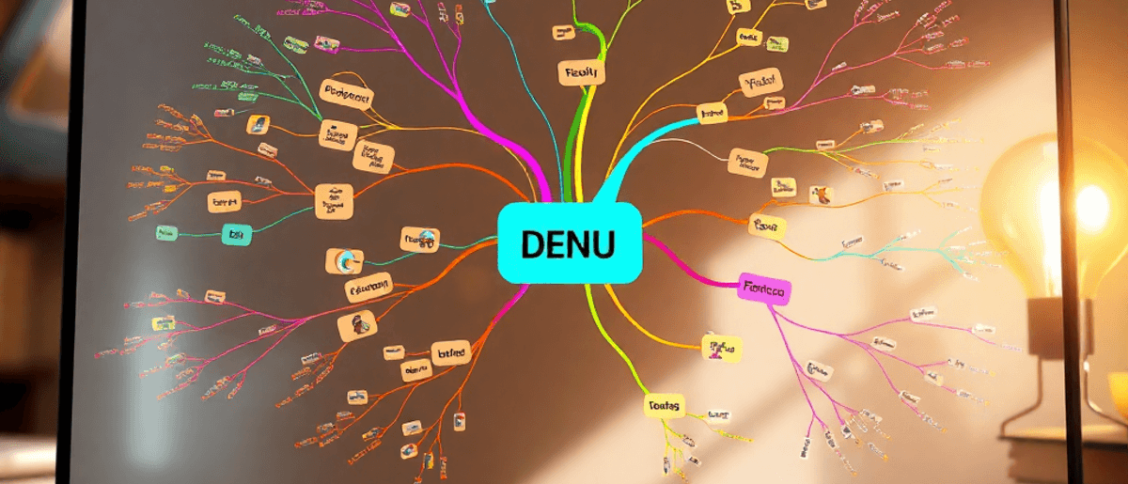Introduction
Mind mapping is a powerful tool for organizing ideas and boosting productivity. It helps you visualize complex concepts, making it easier to plan projects and brainstorm effectively.
Vince from the Digital Nomad Institute shares his experience as a digital nomad, having crafted over 100 mind maps for various business ventures. His expertise in visual brainstorming has transformed his approach to business planning, equipping him with techniques that can benefit anyone seeking clarity in their ideas. In this article, we’ll explore how to create mind maps using Canva.
Getting Started with Canva
To create a mind map free using Canva, follow these simple steps to log into your account:
- Visit the Canva Website: Open your web browser and navigate to Canva.com.
- Click on ‘Log In’: Locate the ‘Log In’ button situated at the top right corner of the homepage.
- Enter Your Credentials: Input your email address and password associated with your Canva account. If you’re a new user, consider signing up for a free account.
- Access Your Dashboard: Once logged in, you’ll be directed to your Canva dashboard where you can start exploring templates.
With these steps completed, you’re ready to dive into creating your mind map!
Finding the Perfect Mind Map Template
Choosing the right mind map template can significantly influence the effectiveness of your brainstorming sessions. Canva offers a variety of templates tailored to different needs, making it essential to select one that aligns with your objectives.
Searching for Mind Map Templates in Canva
- Log into your Canva account.
- Use the search bar at the top of the homepage. Type “mind map” and hit enter.
- Browse through the results to find templates that resonate with your style and project requirements.
Importance of Choosing the Right Template
- Customization: A good template provides a solid framework while allowing you to personalize elements such as colors, fonts, and layouts.
- Clarity: The right design enhances readability, ensuring that your ideas are communicated effectively.
- Focus: Selecting a template that suits your needs keeps you concentrated on your central topic without unnecessary distractions.
For example, if you’re brainstorming business ideas, consider using a radio mind map for its spontaneous layout. Alternatively, a hierarchical flow is ideal for structured project planning. Each template serves a specific purpose, reinforcing the need to choose wisely.
However, choosing the right template is just one part of the equation. If you’re also looking to create engaging video content alongside your mind mapping efforts, it’s essential to have the right video editing software. This guide on the best free video editing software for PC without watermark could be beneficial in selecting tools that enhance your video content quality while complementing your brainstorming sessions.
Recommended Mind Map Templates
Selecting the right mind map template can significantly enhance your brainstorming sessions. Here are three standout templates that cater to different planning needs:
- Radio Mind Map: This template is perfect for generating ideas. It allows you to place a central concept at the core and branch out in multiple directions, capturing thoughts as they come. Ideal for visual thinkers, this layout encourages spontaneity and creativity, making it easier to explore various aspects of your business ideas.
- Hierarchical Flow Mind Map: Use this template when you need structured project planning. It provides a clear hierarchy of tasks and sub-tasks, allowing you to see the relationship between different elements. This format is beneficial when laying out complex projects where clarity and organization are crucial.
- Creative Bubble Map: This template excels in content planning. It visually represents information in interconnected bubbles, which helps you brainstorm topics or themes while ensuring that all ideas are related. The flexibility of this format allows for easy adjustments as your content strategies evolve.
These templates not only simplify the process of how to create a mind map on Canva but also tailor your approach to various planning scenarios effectively.
Creating Your Mind Map
Defining your central topic is crucial for an effective mind map. This central point should encapsulate the main focus of your brainstorming session. For example, if you are planning an online course, label your central topic with clarity and emphasis. Utilize the text tool in Canva to create a bold statement using a large font size—32px is ideal for readability.
Once your central topic is established, the next step involves constructing primary branches. These branches represent the key components or categories related to your main idea. To build them effectively:
- Hold down the Shift key while drawing lines to ensure they remain straight.
- Label each primary branch clearly, reflecting specific areas of focus, such as modules for a course or themes for a content calendar.
- Keep your labels concise yet descriptive; this will facilitate easier navigation as you expand on these branches later.
By arranging your mind map in this structured manner, you set a solid foundation for further development of secondary branches and actionable items.
Enhancing Your Mind Map with Visual Elements
Creating an effective mind map goes beyond just the text; it involves a strong visual hierarchy. This helps convey relationships between ideas and make your map more intuitive. A clear visual structure allows you to quickly identify key concepts and their connections.
Using Line Thicknesses for Clarity
To achieve clarity, line thicknesses play a crucial role:
- Primary branches: Use a thickness of 2px. This sets the main ideas apart and gives them prominence.
- Secondary branches: Opt for a thinner line at 1px. This differentiation helps maintain focus on the primary ideas while still organizing supporting details.
Choosing Colors Wisely
In addition to line thicknesses, color combinations can significantly enhance the visual appeal and functionality of your mind map. Here are some effective suggestions:
- Blue and orange: Ideal for creative projects, this combo stimulates innovation and energy.
- Green and purple: Perfect for business planning, evoking professionalism and trust.
- Teal and coral: Recommended for content strategies, offering a fresh and engaging look.
By utilizing these visual elements thoughtfully, you can elevate your mind mapping experience, making it not only functional but also visually striking.
Adding Interactivity and Collaboration Features to Your Mind Map
Creating a mind map on Canva is not just about visual organization; it’s also about enhancing collaboration. One of the standout features of Canva is the ability to add clickable links within your mind map, making your diagrams interactive and functional.
How to Add Clickable Links
- Select an Element: Click on any shape, text box, or image where you want to add a link.
- Add Link: Right-click on the selected element and choose “Add link.”
- Insert URL: Enter the desired URL you want the element to link to and press enter.
This feature transforms static elements into dynamic resources that can lead team members directly to relevant documents, websites, or other digital assets.
Benefits of Interactivity
- Enhanced Collaboration: When working with team members across different time zones, clickable links streamline communication. Team members can access information quickly without navigating away from the mind map.
- Organized Resources: Interactive links help maintain a tidy workspace by centralizing all necessary information within one document.
- Improved Engagement: An interactive mind map keeps collaborators engaged, fostering a more productive brainstorming environment.
Incorporating clickable links into your mind maps will significantly elevate your collaborative efforts and ensure that everyone stays on the same page, regardless of location.
Pro Tips for Effective Mind Mapping on Canva
Creating mind maps in Canva can be a game-changer for your productivity. After crafting over 100 mind maps, I’ve gathered valuable insights that can enhance your experience:
1. Define Clear Objectives
Before diving in, clearly outline what you want to achieve with your mind map. This clarity ensures that your focus remains sharp, helping prioritize tasks effectively. For more insights on how to maintain focus and prioritize tasks, check out this ultimate guide to productivity hacks for entrepreneurs in 2025.
2. Employ Color Coding
Utilize color to signify different categories or priorities. For example, use red for urgent tasks and green for completed items. This visual cue aids in quick identification and enhances overall organization.
3. Utilize Shortcuts
Familiarize yourself with Canva’s keyboard shortcuts. Techniques like holding the Shift key while drawing lines maintain straightness, saving time and reducing frustration.
4. Regularly Update Your Maps
Revisit and revise your mind maps frequently to reflect new information or changes in direction. This practice keeps your ideas current and actionable.
5. Experiment with Layouts
Don’t hesitate to try various layouts and templates. Each project may benefit from a unique structure, so explore different designs until you find the most effective setup for your needs.
Implementing these productivity hacks can significantly streamline your workflow, making mind mapping a more efficient process while enhancing your organizational skills.
Conclusion
You now have the knowledge to turn ideas into plans using Canva’s mind mapping features. Put these techniques into action right away for the greatest effect on your projects.
- Ready to take your skills further?
- Explore our course on utilizing free AI tools at AIPoweredIncome which can significantly enhance your productivity.
Join our community of location-independent entrepreneurs and start mastering how to create a mind map on Canva today! Additionally, consider leveraging some of the best free AI content generators or text-to-image AI generators available online to further enrich your projects. If you’re interested in expanding your skill set, we recommend checking out the best free websites to learn a new skill as well.









